Psst! Hey you. Yeah, you, in the weight room. You may be working hard, but here's betting you're not working to your full potential—or seeing the results that you should. That's because that machine you're on (or that technique you've been taught, or that routine you've fallen into) isn't really all its cracked up to be. To offer you some better ways to strengthen and condition, we talked to personal trainers Tom Holland and Lance Cummings—two guys who coach indoor and outdoor elite athletes, and who have seen plenty of inefficient, overrated, or even downright dangerous exercises in their day. Here's what they wish they could say to those guys in the gym, and the moves they'd like to prescribe them instead.
Hip Abduction/Adduction Machines
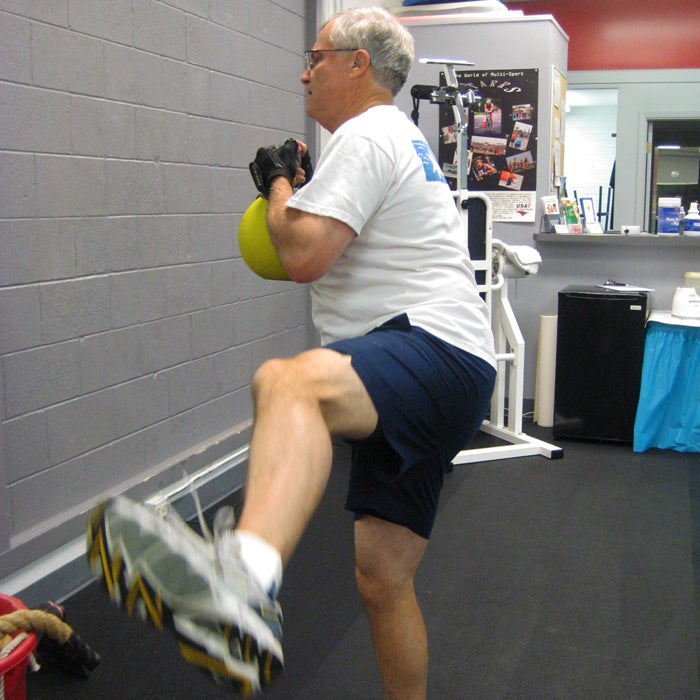
Instead, try: Standing hip abduction and adduction. Stand next to a cable machine and strap the ankle cuff to the ankle farthest from the machine. (You can also tie a wide, flat resistance band around a stationary post and loop your ankle through that.) Stand on the opposite leg and raise your cuffed leg straight out to your side for abduction, with the cable acting as resistance. For adduction, switch legs or rotate your body so that the cuff is on the ankle closest to the machine, and bring your lifted leg across your body. Even though you're only moving one hip at a time with this variation, Holland says, you're also working your core—and more muscles throughout your legs—at the same time. (YPB/Flickr)
Most machines that involve (a) sitting and (b) toning just one muscle group aren't worth your time, says Tom Holland, an exercise physiologist and Chief Fitness Officer of Austin-based Motility Training, LLC. “They may be helpful to beginners, to help get you strong—but then you should really move away from the machines pretty quickly,” he says. Why? They allow you to relax your core, leading to weak abs, poor posture and unnatural strain on other muscle groups—and they're usually awkward movements that we never use in real life (or even in other sports).
Instead, try: Standing hip abduction and adduction. Stand next to a cable machine and strap the ankle cuff to the ankle farthest from the machine. (You can also tie a wide, flat resistance band around a stationary post and loop your ankle through that.) Stand on the opposite leg and raise your cuffed leg straight out to your side for abduction, with the cable acting as resistance. For adduction, switch legs or rotate your body so that the cuff is on the ankle closest to the machine, and bring your lifted leg across your body. Even though you're only moving one hip at a time with this variation, Holland says, you're also working your core—and more muscles throughout your legs—at the same time.
Leg Extension Machine
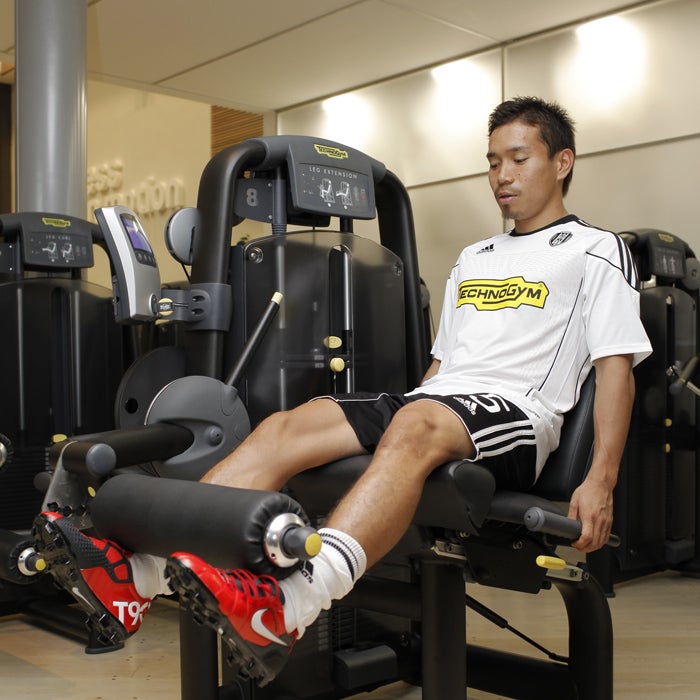
Instead, try: Freestanding squats and lunges. In the same Mayo Clinic study, squats were found to put less stress on the joints and better strengthen the quads. The researchers determined that "closed-chain kinetic exercises," in which the foot is fixed on the ground and the joints all move together, were safer than "open-chain" ones in which the foot hangs free and the foot, knee, and hip joints all move independently. (Technogym/Flickr)
The seated leg extension or knee extension machine has similar problems, says Lance Cummings, training director at SEALFit (a training center staffed by former Navy SEALS) in Encinitas, California; it's too easy to forget about sitting up straight and engaging your core. Plus, he adds, “Anything that sits you in a machine is going to limit your range of motion and mobility.” The leg extension machine also adds unnecessary stress on the ACL, a found, which can be especially risky for athletes who are already hard on their knees.
Instead, try: Freestanding squats and lunges. In the same Mayo Clinic study, squats were found to put less stress on the joints and better strengthen the quads. The researchers determined that “closed-chain kinetic exercises,” in which the foot is fixed on the ground and the joints all move together, were safer than “open-chain” ones in which the foot hangs free and the foot, knee, and hip joints all move independently.
Smith Machine

Instead, try: Flipping a tire. Sure, you could do free-weight squats too—but for an even more functional, full-body workout, Cummings suggests getting out of the gym. "Pick up a tire and flip it 20 times," he says. "That's going to work not just your legs, but also your lower back, your arms, and your core." (Sandra Copra/Flickr)
This machine allows you to squat with a weighted bar, without worrying about dropping it on yourself as you go (you can secure it at any time if it gets too heavy). But a University of Saskatchewan study found that squats with free weights boosted muscle activity 43 percent more than those done on the . The fixed track that the bar travels on forces you into an awkward position, says Cummings, allowing you to only move the bar straight up and down, rather than a more natural down-and-back as you bend your knees.
Instead, try: Flipping a tire. Sure, you could do free-weight squats too—but for an even more functional, full-body workout, Cummings suggests getting out of the gym. “Pick up a tire and flip it 20 times,” he says. “That's going to work not just your legs, but also your lower back, your arms, and your core.”
Kipping Pull-Ups
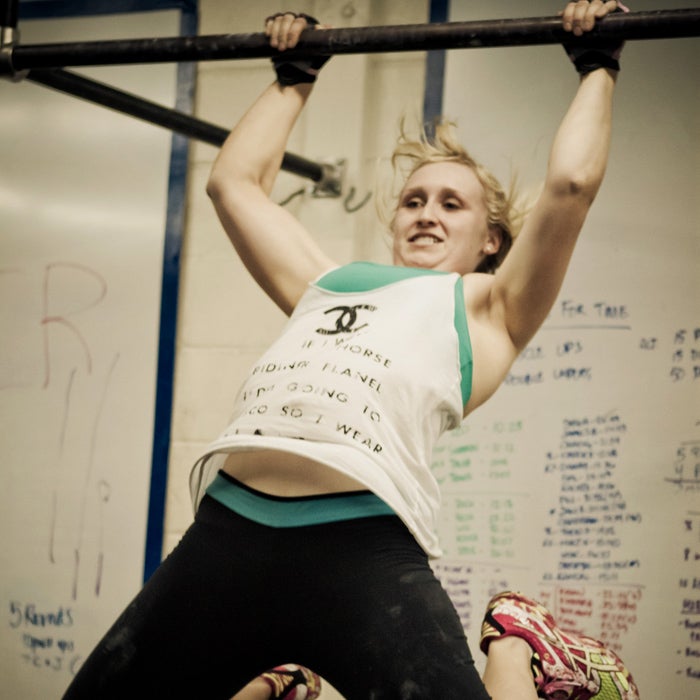
Instead, try: Assisted pull-ups with bands. If you can't do full pull-ups without wriggling around too much on the bar, use a looped resistance band to make it easier. Loop the band through itself around the pull-up bar to secure it in place and place your feet in the opposite end so that it helps to pull you up. (Petranek Fitness/Flickr)
Another exercise that can be killer on the rotator cuff, says Cummings is the kipping pull-up—a move that involves swinging or kicking on the pull-up bar to gather enough momentum to hoist yourself up. It's often used by beginners working their way up to to full pull-ups (or by anyone who's burnt themselves out and is too tired to keep doing them unassisted), but Cummings worries about the prospect of injury and sloppy technique. “Once your form starts being compromised, it's time to shift to a different movement or get off the bar and rest until you can do more quality reps.”
Instead, try: Assisted pull-ups with bands. If you can't do full pull-ups without wriggling around too much on the bar, use a looped resistance band to make it easier. Loop the band through itself around the pull-up bar to secure it in place and place your feet in the opposite end so that it helps to pull you up.
Crunches
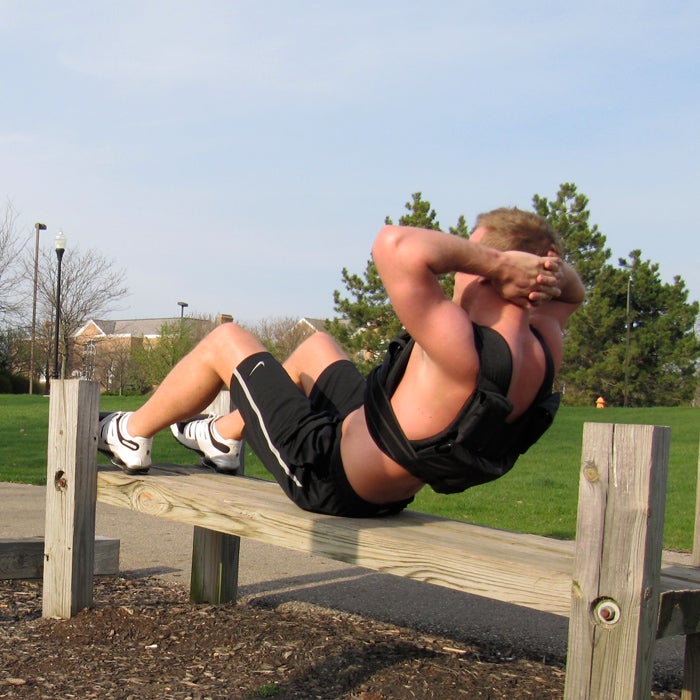
Instead, try: Sit-ups on a stability ball. Sit on a large stability ball and walk yourself forward just enough so that when you lean back, your shoulders, back, and tailbone are supported across the top of the ball. Place your hands behind your head and tuck your chin slightly as you perform a crunching/sit-up motion, curling up until just your upper back is off the ball. Slowly uncurl, allowing yourself to come back to your starting position across the ball. Because you are leaning back slightly more than you would on the ground, this move increases your range of motion, says Cummings—and also the range of muscles you're working as you move. (Resistance WEar)
“You wouldn't do bicep curls only halfway and expect to get full muscle development, so why should you do crunches that only use half of your abs' range of motion and expect to get full ab development?” says Cummings. Crunches will strengthen your middle abdominals, he adds, but it leaves the upper and lower muscles unchallenged— and, therefore, unchanged.
Instead, try: Sit-ups on a stability ball. Sit on a large stability ball and walk yourself forward just enough so that when you lean back, your shoulders, back, and tailbone are supported across the top of the ball. Place your hands behind your head and tuck your chin slightly as you perform a crunching/sit-up motion, curling up until just your upper back is off the ball. Slowly uncurl, allowing yourself to come back to your starting position across the ball. Because you are leaning back slightly more than you would on the ground, this move increases your range of motion, says Cummings—and also the range of muscles you're working as you move.
Russian Twist
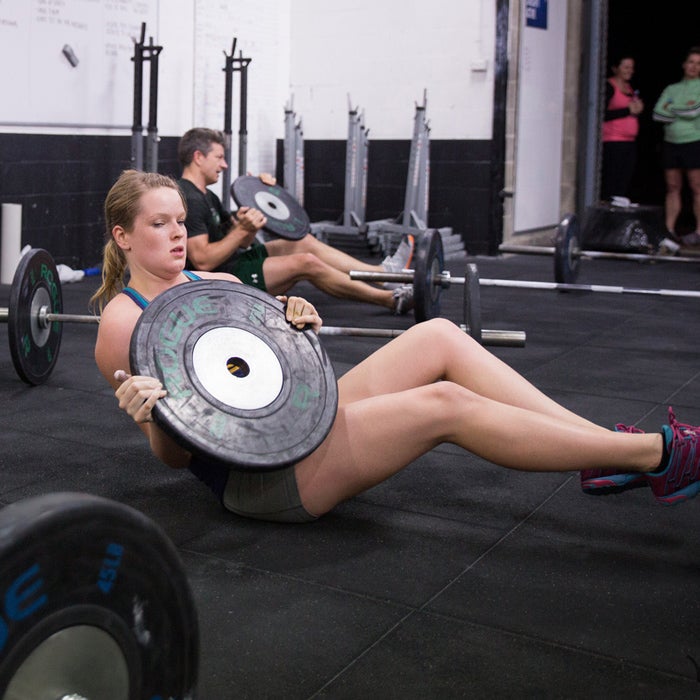
Instead, try: Side plank with rotation. "The plank is a fantastic movement, and one that most people can do correctly," Holland says. To make it more like the Russian Twist, add in side planks on either side, complete with "threading the needle" twists. From the side plank position with your top arm in the air, bring your extended arm down and tuck it under your body as you twist forward, bringing your torso almost parallel with the ground and your arm hovering beneath your chest. Rotate back to side plank and raise your arm overhead again, then repeat several times on both sides. (Yavomo/Flickr)
“This is a good movement—but most people don't do it right,” says Holland. “They sit down and lean back and they tap a medicine ball from one side to another, but they basically just turn it into an arm movement and nothing else.” The move should be executed with the ball held straight out in front and small twists coming from the core. But even for people who start out doing it correctly, it's easy to get lazy and fall back into bad habits, he says.
Instead, try: Side plank with rotation. “The plank is a fantastic movement, and one that most people can do correctly,” Holland says. To make it more like the Russian Twist, add in side planks on either side, complete with “threading the needle” twists. From the side plank position with your top arm in the air, bring your extended arm down and tuck it under your body as you twist forward, bringing your torso almost parallel with the ground and your arm hovering beneath your chest. Rotate back to side plank and raise your arm overhead again, then repeat several times on both sides.
Strength Moves Standing on a Bosu
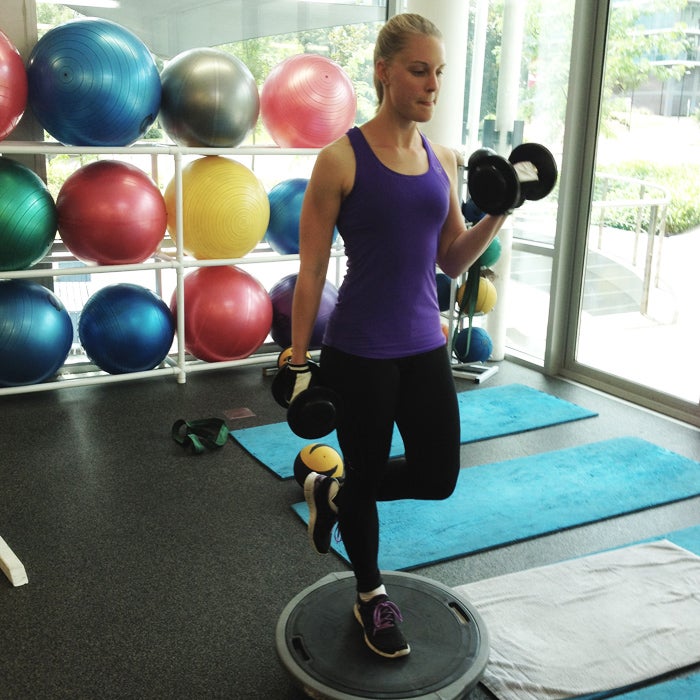
Instead, try: Bicep curls and balance work—separately. "You're better off tackling each part of this independently," Holland says. "If your goal is to strengthen your arms, focus on your arms and do bicep curls on solid ground." If you've got proper form and technique, you should already be engaging your core, he adds. Save the more intense balancing acts for yoga class—or at least for a time when you're not trying to juggle a heavy, potentially dangerous dumbbells in each hand. (Focus Fit Gym/Flickr)
“I see this one a lot in the gym: Someone standing on a Bosu ball doing dumbbell curls,” says Holland. Moves that work more than one body part are generally a good thing, he explains—except when one component cancels out or sabotages the other. “Sure, you're activating your core when you stand on the Bosu, but then you're unsteady and wobbly, and you can't lift as much with your biceps.”
Instead, try: Bicep curls and balance work—separately. “You're better off tackling each part of this independently,” Holland says. “If your goal is to strengthen your arms, focus on your arms and do bicep curls on solid ground.” If you've got proper form and technique, you should already be engaging your core, he adds. Save the more intense balancing acts for yoga class—or at least for a time when you're not trying to juggle a heavy, potentially dangerous dumbbells in each hand.
Glute Kickback
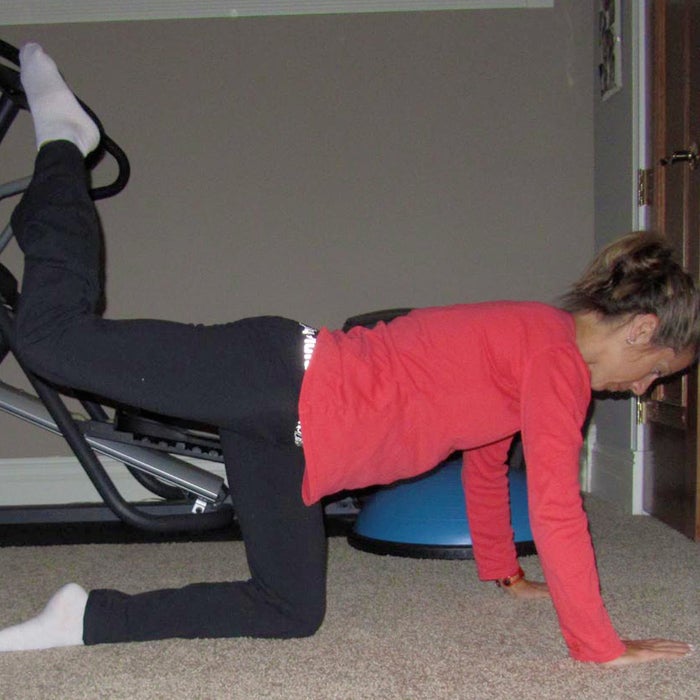
Instead, try: Step ups. "If you want to get outdoors, use a bench and step up on it using one leg 15 or 20 times, then switch to the other leg," says Holland. "That's a much more natural movement that happens in the real world, and that's going to strengthen the entire leg rather than just targeting one muscle group." (Train Body and Mind)
This move, often referred to as the “Donkey Kick” or “Butt Blaster” machine, feeds into the myth that you can “spot reduce” fat on just one part of the body, Holland says. “More women use this, but I see men on it too—thinking that they're going to tone their glutes and reduce fat deposits on their butt, and it just doesn't work,” he says. The move involves resting on your forearms and one knee while you kick the other leg up and back behind you, pushing against a weighted platform.
Instead, try: Step ups. “If you want to get outdoors, use a bench and step up on it using one leg 15 or 20 times, then switch to the other leg,” says Holland. “That's a much more natural movement that happens in the real world, and that's going to strengthen the entire leg rather than just targeting one muscle group.”
Barbell Deadlift
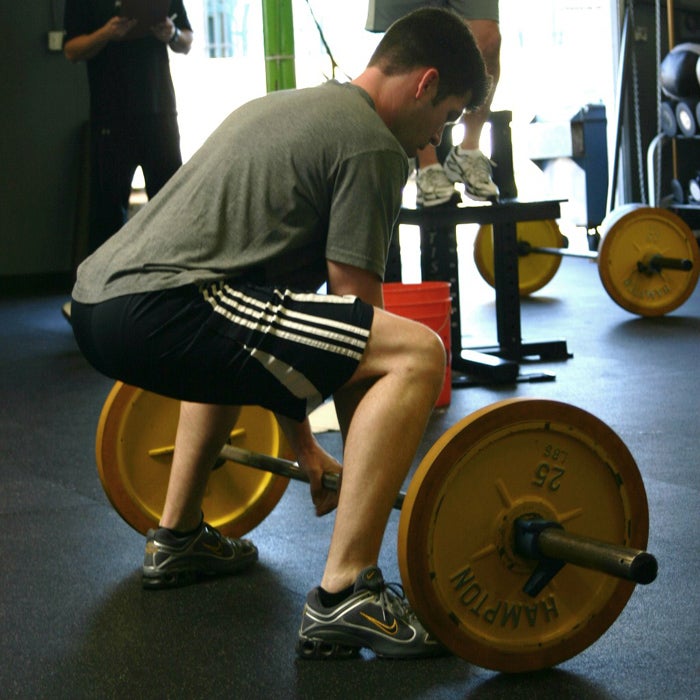
Instead, try: One-legged floor touch. Balance on one leg with your standing knee slightly bent, and hinge at the waist until you can just touch the ground with your fingertips—10 to 15 times per leg. "You can do this indoors or outdoors, and it's much safer," says Holland. "You're not loading your spine, you're working on balance and coordination, you're activating your hamstrings and your glutes—it's very functional." Want to add weight? Hold onto a dumbbell or medicine ball, but nothing too heavy. "It's all about slowing down the movement and engaging the muscles, rather than loading it up with weight and encouraging back problems." (Reactive Gym/Flickr)
“This is another great movement and it can be very effective, but it's too advanced for most people,” says Holland, referring to the act of bending at the knees to lift a (usually very heavy) barbell from the ground to about waist height. “Most trainers don't even teach it correctly. It's vey high-risk, and it's much easier to get hurt than it is to do it right.” (Two common mistakes, according to the American Council on Exercise: Arching the back too much during lifting and lowering, and not raising and lowering your hips and shoulders together.)
Instead, try: One-legged floor touch. Balance on one leg with your standing knee slightly bent, and hinge at the waist until you can just touch the ground with your fingertips—10 to 15 times per leg. “You can do this indoors or outdoors, and it's much safer,” says Holland. “You're not loading your spine, you're working on balance and coordination, you're activating your hamstrings and your glutes—it's very functional.” Want to add weight? Hold onto a dumbbell or medicine ball, but nothing too heavy. “It's all about slowing down the movement and engaging the muscles, rather than loading it up with weight and encouraging back problems.”
Tabata Training
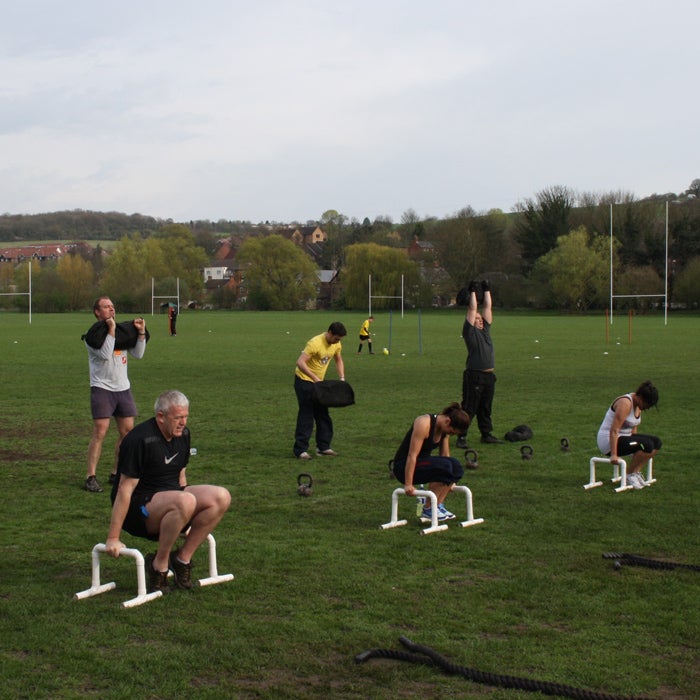
Instead, try: Mixing up different routines. Tabata is a good thing to incorporate into a longer workout, if you're really going to push yourself with all-out explosive moves like sprints or burpees, says Holland. But on the days you don't have it in you, it's probably more effective to focus on longer, lower-intensity intervals. Plus, it helps to mix up your routine and challenge your body in new ways, he adds. Just as you shouldn't jog the same three-mile loop of your neighborhood every day, for example, you also shouldn't let yourself get complacent with the same types of intervals, either. (Wild Training/Flickr)
This buzzword is making a big splash in the world of high-intensity interval training: Essentially, it's a type of workout that includes 20 seconds of intense exercise followed by 10 seconds of rest, repeated eight times for a total of four minutes. In a 2013 Tabata was found to burn 13.5 calories a minute, and to double a person's metabolic rate for half an hour afterward. The problem, Holland says, is that most people don't work hard enough during those 20 seconds intervals: “Gyms have watered it down, so that when they incorporate it into a fitness class it's not nearly intense enough,” he says. “You need to be past 100 percent of your VO2 max—really going all out—for it to have those kinds of results.”
Instead, try: Mixing up different routines. Tabata is a good thing to incorporate into a longer workout, if you're really going to push yourself with all-out explosive moves like sprints or burpees, says Holland. But on the days you don't have it in you, it's probably more effective to focus on longer, lower-intensity intervals. Plus, it helps to mix up your routine and challenge your body in new ways, he adds. Just as you shouldn't jog the same three-mile loop of your neighborhood every day, for example, you also shouldn't let yourself get complacent with the same types of intervals, either.


